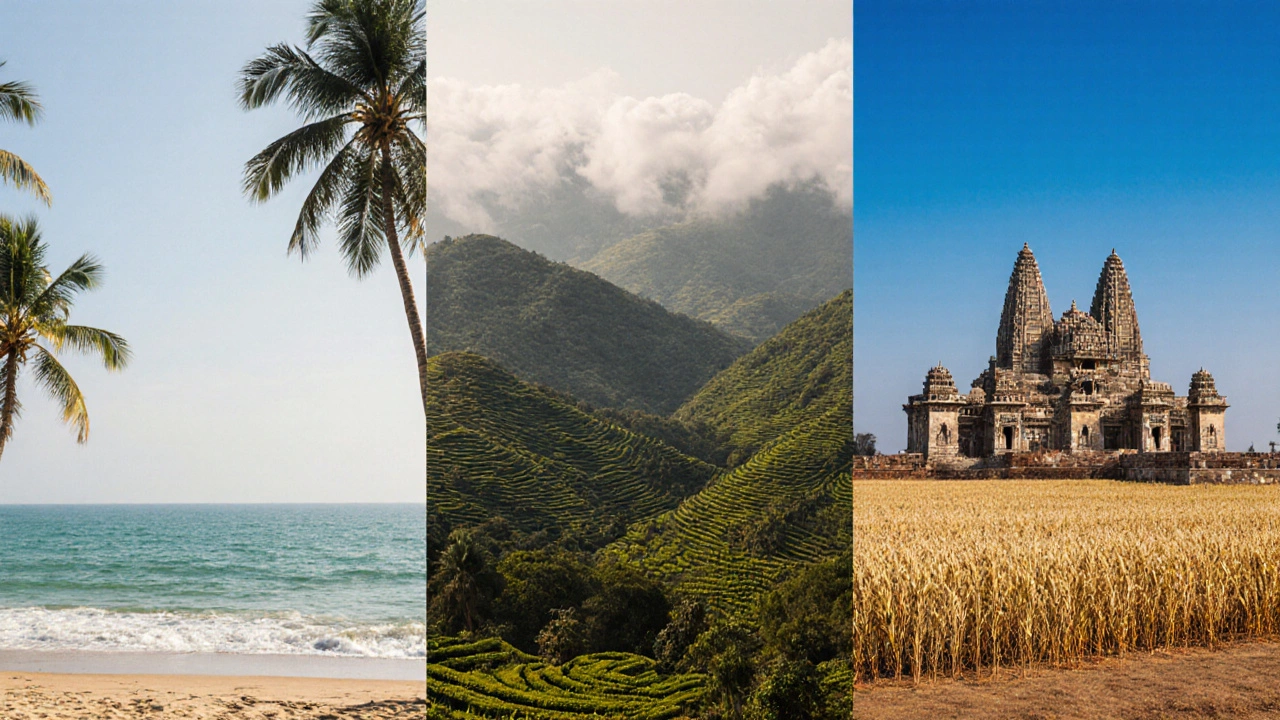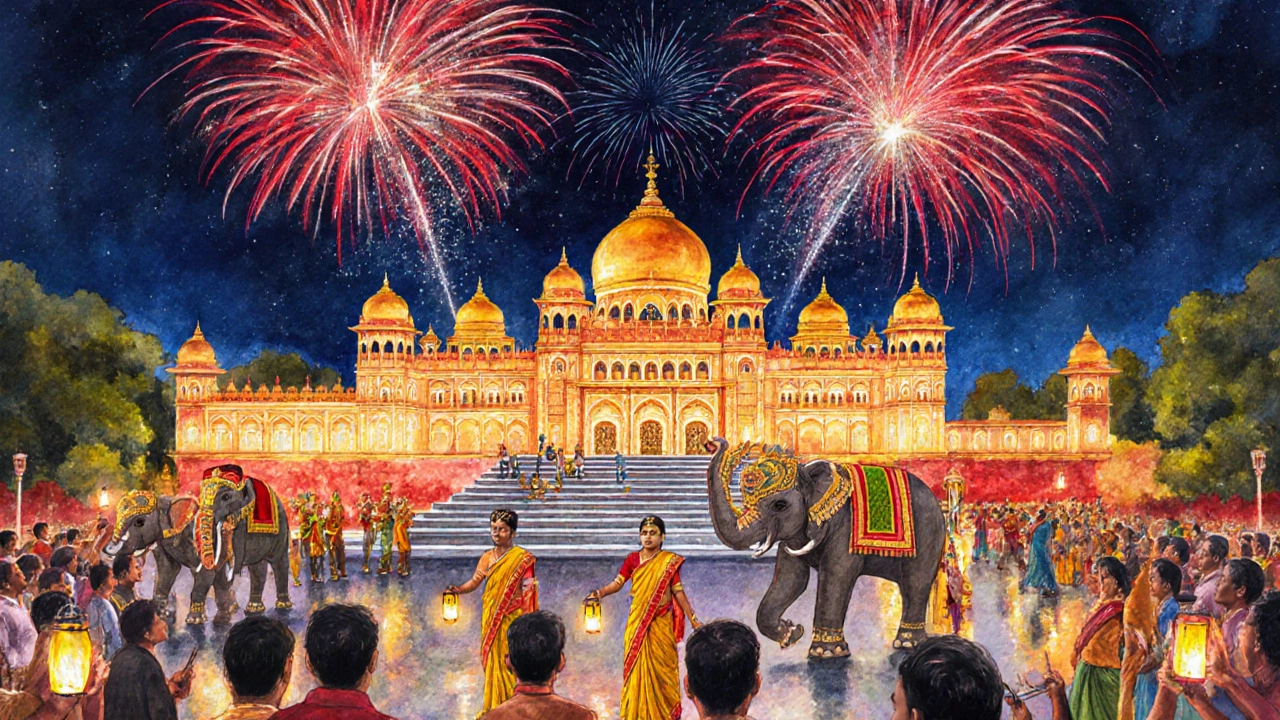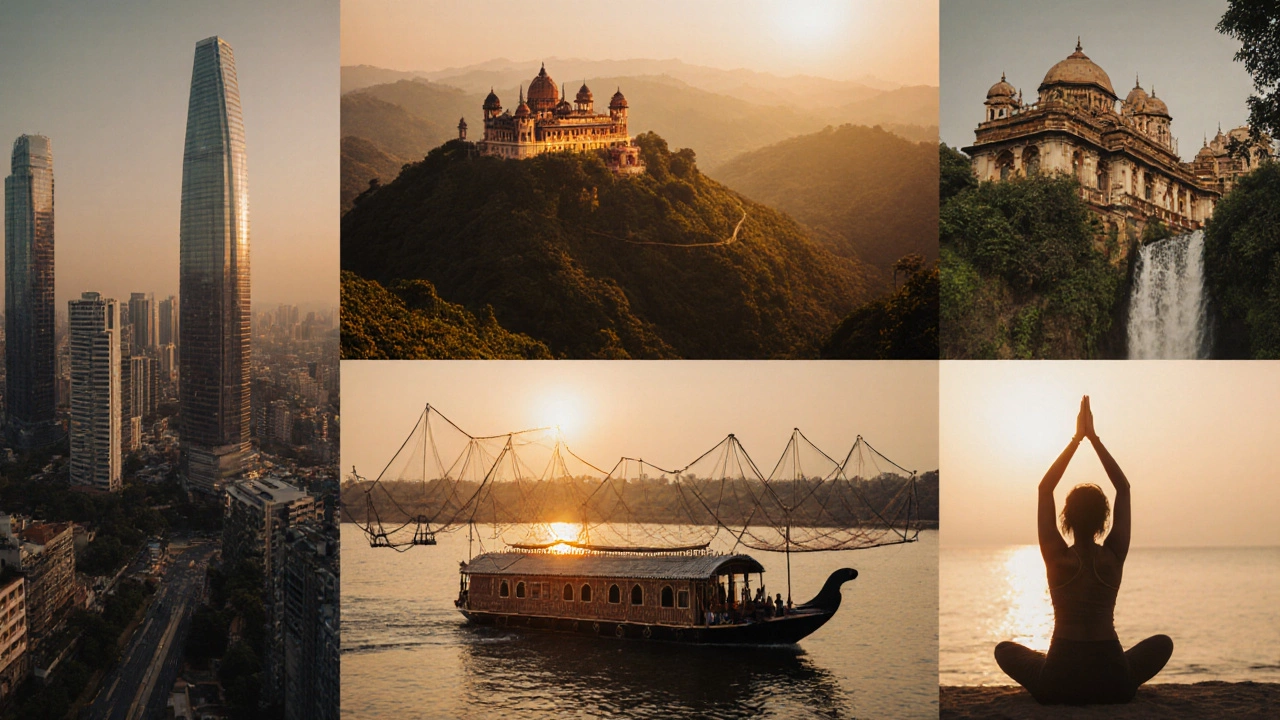Best Month for a South India Tour - When to Visit for Perfect Weather and Experiences
 Oct, 17 2025
Oct, 17 2025
Planning a South India trip but stuck on the calendar? The region’s climate shifts dramatically from coast to hills, making the right month a game‑changer for comfort, festivals, and costs. Below you’ll get a month‑by‑month guide, weather snapshots, festival highlights, price cues, and a few itinerary ideas so you can lock in the perfect travel window.
Understanding South India’s Climate Zones
South India covers five states-Karnataka, Kerala, Tamil Nadu, Andhra Pradesh, and Goa-each with its own micro‑climate. While the coastal belt enjoys a tropical wet‑dry rhythm, the interior plateau experiences cooler winters and hotter summers. Knowing which zone you’ll spend most time in helps you match the month to your comfort level.
- Karnataka - inland plateau (Mysore, Coorg) + coastal stretch (Udupi, Gokarna).
- Kerala - backwaters, Western Ghats, and a long Arabian Sea coastline.
- Tamil Nadu - dry interior (Madurai, Madras) and the Nilgiri hills.
- Andhra Pradesh - long east‑coast beaches and semi‑arid interior.
- Goa - popular beach state with a humid tropical climate.
Two major weather patterns dominate: the Monsoon (June-September) that drenches the coast and hills, and the Winter (November-February) that brings clear skies and moderate temperatures, especially in the interior.
Month‑by‑Month Weather Breakdown
The table below condenses average temperature, rainfall, and humidity for the key states. Values are taken from the Indian Meteorological Department’s 2023‑2024 dataset.
| Month | Avg Temp (°C) | Rainfall (mm) | Humidity % | Best For |
|---|---|---|---|---|
| January | 22‑28 | 10‑30 | 55‑70 | Hill stations, temple festivals |
| February | 23‑30 | 15‑40 | 60‑75 | Wildlife safaris, beach sunrise |
| March | 26‑34 | 30‑80 | 70‑80 | Coastal sunbathing, early trekking |
| April | 28‑36 | 50‑120 | 75‑85 | Backwater cruises (early morning) |
| May | 30‑38 | 120‑250 | 80‑90 | Pre‑monsoon beach festivals |
| June‑September | 27‑34 | 300‑900 | 85‑95 | Monsoon trekking, tea plantation tours |
| October | 26‑33 | 150‑350 | 80‑90 | Post‑monsoon green landscapes |
| November | 24‑30 | 20‑70 | 65‑80 | Cool evenings, festivals |
| December | 22‑28 | 10‑30 | 60‑75 | Coastal cruises, holiday celebrations |
Key Festivals & Events by Month
South India’s cultural calendar can tip the scales when you’re deciding the best month. Here are the standout celebrations that attract both locals and tourists.
- January - Pongal (Tamil Nadu) & Makara Sankranti (Karnataka, Andhra Pradesh): Harvest festivals with vibrant kites, traditional foods, and village fairs.
- February - Thaipusam (Tamil Nadu) & Kerala’s Pooram: Spectacular temple processions, drumbeats, and fireworks.
- March - Karnataka’s Mysore Dasara: Ten‑day royal spectacle featuring parades, illuminated palaces, and cultural shows.
- August - Onam (Kerala): Ten‑day harvest festival, boat races, and elaborate flower carpets.
- October - Navaratri & Dussehra (across South India): Dance, music, and night markets, especially lively in Hyderabad (though technically in central India, nearby).
- December - Christmas in Goa & Coorg’s Kodava festivals: Beach parties, lit-up streets, and unique tribal rituals.
Traveling during a major festival gives you a front‑row seat to local traditions but also means higher accommodation demand and price spikes.

Tourist Crowds & Pricing Trends
Peak season for most South Indian destinations aligns with the cool, dry months of November through February. Expect:
- Hotel rates 20‑35% higher than off‑peak
- Advance booking required for popular beach resorts in Goa and Kerala
- Longer lines at iconic temples like Tirupati and Meenakshi
Conversely, the monsoon window (June‑September) offers lower prices, quieter attractions, and a lush green backdrop-perfect for photographers and avid trekkers willing to brave occasional showers.
Best Month Recommendations by Traveler Type
Rather than a single “best month,” think about what you value most.
- Beach lovers seeking sunshine: Late February to early May (dry, warm, minimal rain).
- Hill‑station enthusiasts (Coorg, Ooty, Kodaikanal): November to February for crisp air and clear views.
- Cultural tourists: January (Pongal, Makara Sankranti) and September‑October (Navaratri, Onam) for vibrant festivals.
- Budget travelers: June to early September - accommodation discounts up to 40% and fewer crowds.
- Wildlife safari fans: October to March, when wildlife spots are active and the forest floor is dry.
Sample Itinerary for the Ideal Month - November
November strikes a sweet spot: pleasant weather, major festivals, and moderate prices. Here’s a 10‑day flow that mixes coast, hills, and heritage.
- Day1‑2: Bangalore (Karnataka) - explore Bangalore Palace, then drive to Mysore.
- Day3‑4: Mysore - attend Mysore Dasara preparations, visit Chamundi Hills.
- Day5‑6: Coorg (Western Ghats) - coffee plantation tour, trek to Abbey Falls.
- Day7‑8: Kochi & Alappuzha (Kerala) - backwater houseboat, Chinese fishing nets, Kathakali show.
- Day9‑10: Varkala or Kovalam (Goa alternative) - unwind on the beach, sunset yoga, fresh seafood.
Adjust the sequence based on flight availability; the internal flights from Bangalore to Kochi shave a day off the road travel.

Practical Tips for Traveling in Different Seasons
- Monsoon (June‑September): Pack a sturdy raincoat, waterproof shoes, and quick‑dry clothing. Opt for indoor attractions (temple museums, spice markets) on heavy‑rain days.
- Winter (Nov‑Feb): Bring a light sweater for evenings in hill stations; coastal areas stay warm, but sea breezes can feel chilly after sunset.
- Summer (Mar‑May): Hydrate often, use sunscreen, and schedule outdoor activities early in the morning.
- Festival periods: Book accommodations at least 3months ahead; use reputable platforms that allow free cancellation.
- Local transport: State‑run buses are reliable year‑round; auto‑rickshaws are best for short city hops. For inter‑state journeys, consider train bookings on the Indian Railways website, especially during peak months.
Remember, South India’s diversity means you can experience a beach sunrise and a hill‑station sunset in the same week-just pick the month that lines up with the experiences you crave.
Quick Takeaways
- November‑February = cool, dry, festival‑rich - ideal for most travelers.
- March‑May = hot but dry - perfect for beach holidays.
- June‑September = monsoon - great for budget, lush scenery, and trekking.
Pick the slot that matches your activity list, and you’ll enjoy South India at its finest.
Frequently Asked Questions
When is the cheapest time to visit South India?
The monsoon months (June‑September) offer the lowest hotel rates, often 30‑40% off peak prices, and fewer tourists at major attractions.
Do I need a visa to travel in South India?
Most foreign visitors need an e‑tourist visa issued online. The process typically takes 3‑5 business days; the visa is valid for 90 days and allows multiple entries.
What clothing is appropriate for temple visits?
Cover shoulders and knees. Women often wear a simple sari or long skirt; men should wear long trousers and a shirt. Avoid caps inside the sanctum.
Is public transport reliable during the monsoon?
Buses and trains generally run on schedule, but occasional delays or road closures can happen in heavy rain. Keep a flexible itinerary and check local news updates.
Which South Indian state is best for wildlife safaris?
Karnataka’s Bandipur and Tamil Nadu’s Mudumalai National Parks are top choices. Visiting between October and March maximizes animal sightings.